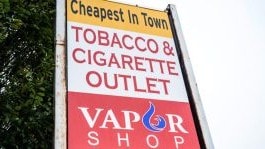At a glance
- The tobacco industry targets low-income communities with marketing and advertising.
- Tobacco companies promote flavored products—like menthol—in neighborhoods where people of low SES live.
- Stress can increase commercial tobacco use and can make health problems worse.

Overview
Some policies and practices have led to mental and physical health risks and challenges, and related long-term health outcomes, for people with low socioeconomic status (SES).
People with low SES have been harmed by unjust practices related to the sale of commercial tobacco.A Tobacco companies have a long history of using samples and giveaways to entice people with low SES to try and use their harmful products. For example, tobacco companies have handed out free cigarettes to children in public housing complexes, homeless shelters, and soup kitchens.12 They have also included coupons for cigarettes in mailings for government food stamps.3

Other policies and practices related to the social environment also affect health and health outcomes of people with low SES. For example:
- Lower quality education is associated with lower health literacy, fewer opportunities for employment, less ability to access enough healthy food, and less access to health care, all of which negatively affect health outcomes.4 People with low SES are more likely to live in neighborhoods where most people rent (vs own their own home). K–12 schools, funded primarily through local property taxes, are subsequently under-funded.5
- City, county, state, and federal courts can impose fines, fees, and other forms of legal financial obligations on people for traffic violations and other minor offenses. For people without the means to pay, these legal debts can trigger serious and escalating consequences—from the loss of a driver's license to jail time. These court-imposed fines and fees can add stress and negatively affect health outcomes for people with low SES.67
- Rural communities with low SES can lack resources (for example, financial resources, access to services), which can serve as a barrier to support for tobacco education, prevention, and cessation.8
People with low SES have also been excluded from systems meant to protect and improve health and well-being, including health care and medical science.
- People with lower incomes have less access to health care, including affordable health care needed to address smoking-related morbidities.9 People who have unmet needs (including economic or job instability, lack of housing) are more likely to go to the emergency room, to miss medical appointments, and to have unmanaged medical conditions compared to those with met needs.1011
- Being uninsured is related to health care disparities. People who are uninsured may decide not to get needed clinical screening (which could include for tobacco use or cancer) and routine or recommended care due to out-of-pocket cost.12
- People with lower incomes are more likely to experience delayed access to health care, which can result in adverse health outcomes.1314
- People with low incomes are less likely to be included in clinical trials for new cancer treatments.15 The lack of lower income populations included in clinical trials could potentially limit knowledge of the effectiveness of treatments across all populations.
The tobacco industry targets low-income communities with marketing and advertising
Marketing plays a big role in whether people try or use commercial tobacco products. Being around commercial tobacco ads makes smoking appear more appealing and increases the chance that someone will try smoking for the first time or start using commercial tobacco products regularly.16171819
- Neighborhoods where people have lower incomes tend to have more stores selling and advertising commercial tobacco.20 In neighborhoods with a lower SES there are a significantly higher weekly unit sales of tobacco products per tobacco retail store.21 Schools that have a larger proportion of low-income students are more likely to have stores selling commercial tobacco near those schools.22
- More stores selling commercial tobacco means more advertisements for products like cigarettes, e-cigarettes, chewing tobacco, or other commercial tobacco products. People who see commercial tobacco promotions in places where these products are sold are more likely to smoke.2324 Tobacco companies target in-store marketing campaigns toward neighborhoods where most residents have low income.3
- Tobacco companies target communities with low incomes by using price promotions to increase sales, such as discounts, coupons, and special sales.25

Tobacco companies promote flavored products—like menthol—in neighborhoods where people of low SES live.
Menthol has a minty flavor that masks the harsh taste of tobacco. Menthol makes cigarette smoke feel easier to inhale and can make it harder to quit smoking.2627 To attract customers, tobacco companies target low-income communities with advertising and sales of flavored cigarettes and cigars—especially those with menthol. This can help explain why people with lower income and less education tend to smoke menthol cigarettes at a higher rate than groups with higher incomes and more education.2829
States and communities can take action to make flavored tobacco products less available.
Stress can increase commercial tobacco use, and can make health problems worse
When people face many forms of stress—like financial problems, discrimination, or unsafe neighborhoods—they can be more likely to smoke.323334
The pressures of poverty help explain why the health problems caused by commercial tobacco tend to be worse for people with low SES. When people have severe or long-lasting stress, their bodies respond by raising stress hormones and keeping them raised. When this goes on for a long time, they may develop health problems like high blood pressure and type 2 diabetes.3536 Smoking cigarettes also leads to disease and disability and harms nearly every organ of the body.16
- "Commercial tobacco" means harmful products that are made and sold by tobacco companies. It does not include "traditional tobacco" used by Indigenous groups for religious or ceremonial purposes.
- Tobacco Control Legal Consortium. Evans v. Lorillard: A Bittersweet Victory Against the Tobacco Industry [PDF - 472 KB]. https://publichealthlawcenter.org/sites/default/files/resources/tclc-Evans-v-Lorillard-case-study-2016.pdf. Published 2016. Accessed March 21, 2022.
- Apollonio DE, Malone RE. Marketing to the Marginalised: Tobacco Industry Targeting of the Homeless and Mentally Ill. Tob Control. 2005;14:409-415. DOI: 10.1136/tc.2005.011890.
- Brown-Johnson CG, England LJ, Glantz SA, Ling PM Tobacco Industry Marketing to Low Socioeconomic Status Women in the U.S.A. Tob Control. 2014; 23(e2):e139–e146. DOI: 10.1136/tobaccocontrol-2013-051224.
- Baciu A, Negussie Y, Geller A, and Weinstein JN. Communities in Action: Pathways to Health Equity. Washington (DC): National Academies Press (US). National Academies of Sciences, Engineering, and Medicine; January 11, 2017. https://nap.nationalacademies.org/catalog/24624/communities-in-action-pathways-to-health-equity. Accessed March 21, 2022.
- US Department of Housing and Urban Development. Breaking Down Barriers: Housing, Neighborhoods, and Schools of Opportunity [PDF - 2.4 MB]. Published April, 2016. Accessed March 21, 2022.
- Martin KD, Sykes BL, Shannon S, Edwards F, Harris A. Monetary Sanctions: Legal Financial Obligations in US Systems of Justice. Annual Rev Criminology. 2018;1:1:471-495. DOI: https://doi.org/10.1146/annurev-criminol-032317-091915
- Harris A, Smith T. Monetary Sanctions as Chronic and Acute Health Stressors: The Emotional and Physical Strain of People Who Owe Court Fines and Fees. RSF: The Russell Sage Foundation Journal of the Social Sciences. 8(2): 36–56. DOI: https://doi.org/10.7758/RSF.2022.8.2.02.
- Stewart T, Formica MK, Adachi-Mejia AM, Wang D, Gerrard M. A Tobacco Cessation Intervention with Rural, Medically Underserved, Blue-collar Employees: A Quasiexperimental Study. Saf Health Work. 2016;7(4):293-298. DOI: 10.1016/j.shaw.2016.03.001.
- Institute of Medicine. Ending the Tobacco Problem: A Blueprint for the Nation. The National Academies Press; 2007. https://nap.nationalacademies.org/catalog/11795/ending-the-tobacco-problem-a-blueprint-for-the-nation. Accessed March 21, 2022.
- Cole MB, Nguyen KH. Unmet Social Needs Among Low-Income Adults in the United States: Associations With Health Care Access and Quality. Health Serv Res. 2020;55 2(2):873-882. DOI: https://doi.org/10.1111/1475-6773.13555
- Kushel MB, Gupta R, Gee L, Haas JS. Housing Instability and Food Insecurity as Barriers to Health Care Among Low-Income Americans. J Gen Intern Med. 2006;21(1):71-77. DOI: 10.1111/j.1525-1497.2005.00278.x.
- National Academies of Sciences, Engineering, and Medicine; Health and Medicine Division; Board on Health Care Services; Committee on Health Care Utilization and Adults with Disabilities. Health-Care Utilization as a Proxy in Disability Determination. National Academies Press; 2018. Accessed March 21, 2022. https://nap.nationalacademies.org/catalog/24969/health-care-utilization-as-a-proxy-in-disability-determination
- Weissman JS, Stern R, Fielding SL, Epstein AM. Delayed Access to Health Care: Risk Factors, Reasons, and Consequences. Ann Intern Med. 1991;114(4):325-331. DOI: 10.7326/0003-4819-114-4-325.
- Prentice JC, Pizer SD. Delayed Access to Health Care and Mortality. Health Serv Res. 2007;42(2):644-662. DOI: 10.1111/j.1475-6773.2006.00626.x.
- Unger JM, Gralow JR, Albain KS, Ramsey SD, Hershman DL. Patient Income Level and Cancer Clinical Trial Participation: A Prospective Survey Study. JAMA Oncol. 2016;2(1):137-9. DOI: 10.1001/jamaoncol.2015.3924..
- S. Department of Health and Human Services. The Health Consequences of Smoking—50 Years of Progress: A Report of the Surgeon General. U.S. Department of Health and Human Services, Centers for Disease Control and Prevention; 2014. Accessed March 21, 2022. https://pubmed.ncbi.nlm.nih.gov/24455788/
- Carson NJ, Rodriguez D, Audrain-McGovern J. Investigation of Mechanisms Linking Media Exposure to Smoking in High School Students. Prev Med. 2005;41(2):511-20. DOI: 10.1016/j.ypmed.2005.01.002.
- Charlesworth A and Glantz S. Smoking in the Movies Increases Adolescent Smoking: A Review. Pediatrics. 2005;116(6): 516-28. DOI: 10.1542/peds.2005-0141.
- Yu D, Peterson NA, Sheffer MA, Reid RJ, Schneider JE. Tobacco Outlet Density and Demographics: Analysing the Relationships with a Spatial Regression Approach. Public Health. 2010;124(7):412–6. DOI: 10.1016/j.puhe.2010.03.024.
- Wallace LA, Paul R, Gholizadeh S, Zadronzy W, Webster C, Mayfield M, et al. Neighborhood Disadvantage and the Sales of Unhealthy Products: Alcohol, Tobacco and Unhealthy Snack Food. BMC Public Health. 2021;21(1):1361. https://bmcpublichealth.biomedcentral.com/articles/10.1186/s12889-021-11442-z. Accessed March 21, 2022.
- D'Angelo H, Ammerman A, Gordon-Larsen P, Linnan L, Lytle L, Ribisl KM. Sociodemographic Disparities in Proximity of Schools to Tobacco Outlets and Fast-Food Restaurants. Am J Public Health. 2016;106(9):1556-1562. DOI: 10.2105/AJPH.2016.303259.
- Groom AL, Cruz-Cano R, Mead EL, et al. Tobacco Point-of-Sale Influence on U.S. Adult Smokers. J Health Care Poor Underserved. 2020;31(1):249-264 [accessed 2022 Mar 21].
- Lee JG, Henriksen L, Rose SW, Moreland-Russell S, Ribisl KM. A Systematic Review of Neighborhood Disparities in Point-of-Sale Tobacco Marketing. Am J Public Health. 2015;105(9):e8-e18. DOI: 10.2105/AJPH.2015.302777.
- Mills SD, Golden SD, Henriksen L, Kong AY, Queen TL, Ribisl KM. Neighbourhood Disparities in the Price of the Cheapest Cigarettes in the USA. J Epidemiol Community Health. 2019;73(9):894-896. DOI:10.1136/jech-2018-210998.
- Ton HT, Smart AE, Aguilar BL, Olson TT, Kellar KJ, Ahern GP. Menthol Enhances the Desensitization of Human Alpha3Beta4 Nicotinic Acetylcholine Receptors. Mol Pharmacol. 2015;88(2):256-64. DOI: 10.1124/mol.115.098285
- Oliver AJ, Jensen JA, Vogel RI, Anderson AJ, Hatsukami DK. Flavored and Nonflavored Smokeless Tobacco Products: Rate, Pattern of Use, and Effects. Nicotine Tob Res. 2013;15(1):88-92. DOI: 10.1093/ntr/nts093.
- Lee JG, Henriksen L, Rose SW, Moreland-Russell S, Ribis KM. A Systematic Review of Neighborhood Disparities in Point-of-Sale Tobacco Marketing. Am J Public Health. 2015;105(9), e8–e18. DOI: 10.2105/AJPH.2015.302777.
- Food and Drug Administration. Preliminary Scientific Evaluation of the Possible Public Health Effects of Menthol Versus Nonmenthol Cigarettes [PDF - 1.6 MB]. Food and Drug Administration; 2013. Accessed March 21, 2022. https://permanent.access.gpo.gov/gpo39032/Preliminary%20Scientific%20Evaluation%20Menthol%20508%20reduced.pdf
- Robertson L, McGee R, Marsh L, Hoek J. A Systematic Review on the Impact of Point-of-Sale Tobacco Promotion on Smoking. Nicotine Tob Res. 2015; 17(1): 2-17. DOI: 10.1093/ntr/ntu168.
- Harrell MB, Loukas A, Jackson CD, Marti CN, & Perry CL. Flavored Tobacco Product Use Among Youth and Young Adults: What if Flavors Didn't Exist? [PDF - 7.69 KB]. Tob Regul Sci. 2017;3(2): 168-173. DOI:10.18001/TRS.3.2.4.
- Tsai J, Homa DM, Gentzke AS, Mahoney M, Sharpova SR, Sosnoff CS, et al. Exposure to Secondhand Smoke Among Nonsmokers — United States, 1988–2014. MMWR Morb Mortal Wkly Rep. 2018;67:1342–1346. DOI: http://dx.doi.org/10.15585/mmwr.mm6748a3.
- Purnell JQ, Peppone LJ, Alcaraz K, et al. Perceived Discrimination, Psychological Distress, and Current Smoking Status: Results from the Behavioral Risk Factor Surveillance System Reactions to Race Module, 2004-2008. Am J Public Health. 2012;102(5):844-851. DOI: https://doi.org/10.2105/AJPH.2012.300694.
- Juster RP, McEwen BS, Lupien SJ. Allostatic Load Biomarkers of Chronic Stress and Impact on Health and Cognition. Neurosci Biobehav Rev. 2010; 35(1), 2-16. DOI: 10.1016/j.neubiorev.2009.10.002.
- Guyll M, Matthews KA, Bromberger JT. Discrimination and Unfair Treatment: Relationship to Cardiovascular Reactivity Among African American and European American women. Health Psychol. 2001;20(5): 315. DOI: 10.1037//0278-6133.20.5.315.
- Babb S, Malarcher A, Schauer G, Asman K, Jamal A. Quitting Smoking Among Adults — United States, 2000–2015. MMWR Morb Mortal Wkly Rep. 2017;65:1457–1464. DOI: http://dx.doi.org/10.15585/mmwr.mm6552a1.
- Drope J, Liber AC, Cahn Z, Stoklosa M, Kennedy R, Douglas CE, et al. Who's Still Smoking? Disparities in Adult Cigarette Smoking Prevalence in the United States. CA Cancer J Clin. 2018;68(2):106–115. DOI: 10.3322/caac.21444.
